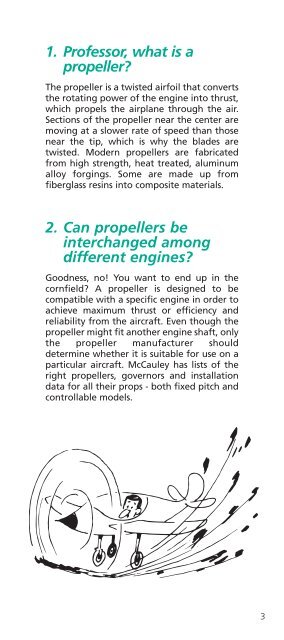propeller performance - McCauley Propeller Systems - Textron
propeller performance - McCauley Propeller Systems - Textron
propeller performance - McCauley Propeller Systems - Textron
You also want an ePaper? Increase the reach of your titles
YUMPU automatically turns print PDFs into web optimized ePapers that Google loves.
1. Professor, what is a<br />
<strong>propeller</strong>?<br />
The <strong>propeller</strong> is a twisted airfoil that converts<br />
the rotating power of the engine into thrust,<br />
which propels the airplane through the air.<br />
Sections of the <strong>propeller</strong> near the center are<br />
moving at a slower rate of speed than those<br />
near the tip, which is why the blades are<br />
twisted. Modern <strong>propeller</strong>s are fabricated<br />
from high strength, heat treated, aluminum<br />
alloy forgings. Some are made up from<br />
fiberglass resins into composite materials.<br />
2. Can <strong>propeller</strong>s be<br />
interchanged among<br />
different engines?<br />
Goodness, no! You want to end up in the<br />
cornfield? A <strong>propeller</strong> is designed to be<br />
compatible with a specific engine in order to<br />
achieve maximum thrust or efficiency and<br />
reliability from the aircraft. Even though the<br />
<strong>propeller</strong> might fit another engine shaft, only<br />
the <strong>propeller</strong> manufacturer should<br />
determine whether it is suitable for use on a<br />
particular aircraft. <strong>McCauley</strong> has lists of the<br />
right <strong>propeller</strong>s, governors and installation<br />
data for all their props - both fixed pitch and<br />
controllable models.<br />
3



